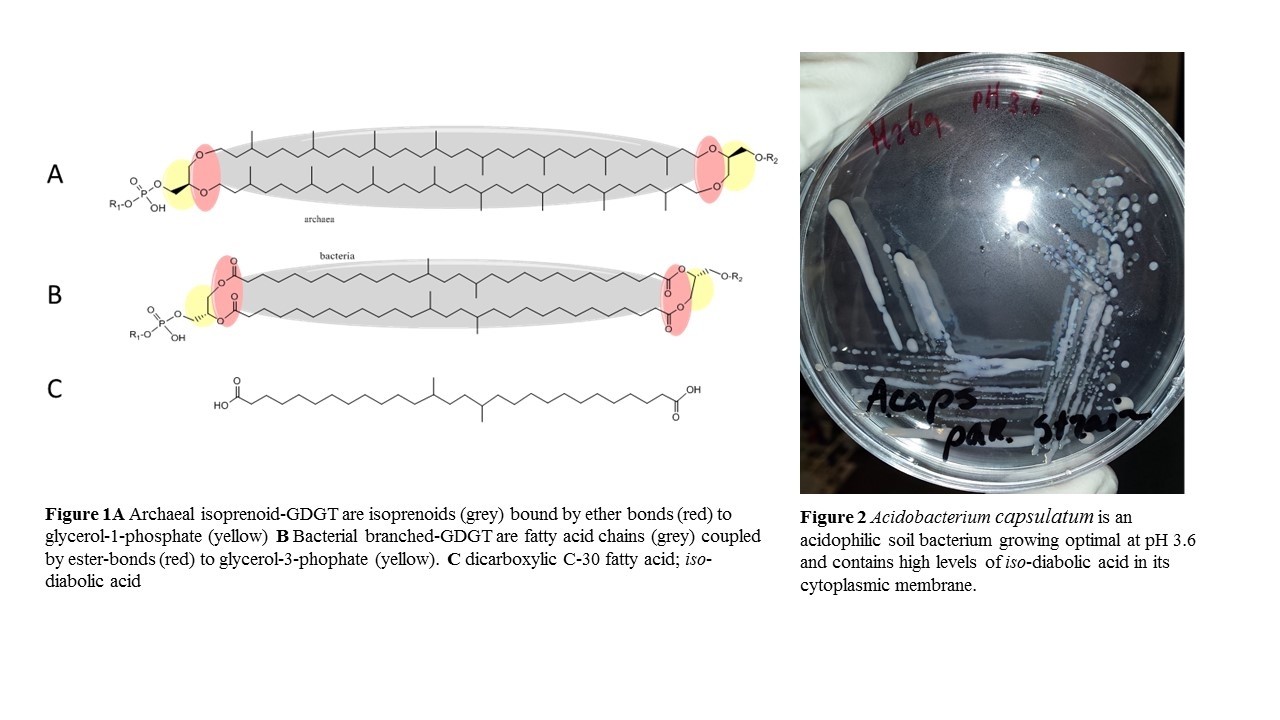Inactive user
The page you are trying to access has been deactivated because Melvin Siliakus is not working for NIOZ anymore.
Go to Staff.
Archaeal and Bacterial membrane lipids exhibit a high degree of variability, in which the most striking one is the formation of glycerol-dialkyl-glycerol tetraethers (GDGT’s) (Fig. 1 A and B resp.). These structures are bipolar molecules for which an as yet unidentified mechanism condenses the two tail-ends of two C20 isoprenoid chains to form C40-isoprenoids in Archaea, or two iso-C15 fatty acid chains to form C30 fatty acid (iso-diabolic acid (Fig 1 C) in Bacteria. In bulk, the GDGT’s form a monolayer membrane instead of the traditional structure of the double leaflet bilayer membrane. GDGT’s contribute considerably to an increased stability and a reduced permeability of the archaeal and bacterial membrane (Siliakus M.F. et al. Extremophiles 2017). In contrast to diether synthesis, little information is available on the suspected tail-to-tail condensation required for synthesizing tetraether lipids. Moreover, the responsible gene(s) and protein(s) involved have not yet been identified. A recent publication speculated about a potential biosynthesis via a mechanism dubbed the multiple key multiple lock mechanism (Villanueva et al. 2014). Here we aim to gain new insight into the condensation mechanism by studying the production of iso-diabolic acid in Acidobacterium capsulatum, an acidophilic bacterium abundant in soil (Fig. 2). We analyse its transcriptome and proteome when grown under various conditions.

Previous Research:
Life on earth can be divided into three domains, the Eukarya, Archaea and Bacteria. The last two groups at first glance seem very similar, but have enough essential differences to divide them into separate domains. Due to differences in the chemical structure of the membrane lipids, the Archaea and the Bacteria are able to survive under stringent conditions. Archaea, for example, are more resistant to extreme conditions, such as low pH, a high temperature or the presence of solvents. The presumption is therefore that archaeal membranes are more robust than bacterial membranes. In my previous study, we therefore engineered the enzymes for the assembly of archaeal lipids into the bacterium Escherichia coli, with the aim to form a mixed membrane with an improved stability. The constructed E.coli was indeed found to possess a mixed membrane with a surprisingly high amount of archaeal lipids (28%). Although at certain conditions these adjustment led to severe morphological changes, the cells were observed to have more robust properties on exposure to heat, cold, and butanol. More stable E. coli cells are of interest for industrial applications, where often extreme conditions are being used.
Education and scientific experiences:
PhD: Bacterial genetics, Wageningen UR, laboratory of Microbiology, issued nov. 2016
MSc: Pathobiology and Toxicology, Radboud University Nijmegen, Biomedical sciences,
issued sept. 2010
BSc: Biochemistry, HAN university, Hogeschool Arnhem Nijmegen, Biological and Medical
Laboratory research, issued aug. 2006
Intern: TNO Netherlands Organization for Scientific Research, dept. R&D Quality of Life,
Zeist, 2010
Intern: UMC St. Radboud, dept. Pathology, Msc thesis, 2009
Intern: CHORI, Children’s Hospital Oakland research institute, Frans Kuypers lab. Oakland USA, Bsc-thesis, 2005
Publications:
Antonella Caforio, Melvin F. Siliakus, Marten Exterkate, Samta Jain, Varsha R. Jumde, Ruben L.H. Andringa, Servé W. M. Kengen, Adriaan J. Minnaard, Arnold J.M. Driessen, John van der Oost. Converting Escherichia coli into an archaebacterium with a hybrid heterochiral membrane, PNAS 2018 March 19;
Nico J. Claassens, Melvin F. Siliakus, Sebastiaan K. Spaans, Sjoerd C.A. Creutzburg, Bart Nijsse, Peter J. Schaap, Tessa E.F. Quax, John van der Oost. Improving heterologous membrane protein production in Escherichia coli by combining transcriptional tuning and codon usage algorithms, PLOS one, September 2017
Melvin F. Siliakus, John van der Oost, Servé W.M. Kengen. Adaptations of archaeal and bacterial membranes to variations in temperature, pH and pressure. Extremophiles 2017 Jul 21; 651-670
Franklin L. Nobrega, Ana Rita Costa, José F. Santos, Melvin F. Siliakus, Jan W.M. van Lent, Servé W.M. Kengen, Joana Azeredo, Leon D. Kluskens. Genetically manipulated phages with improved pH resistance for oral administration in veterinary medicin. Nature Scientific Reports. 2016 Dec 6;
Antonella Caforio, Samta Jain, Peter Fodran, Melvin F. Siliakus, Adriaan J. Minnaard, John van der Oost, Arnold J.M. Driessen. Formation of the ether lipids archaetidylglycerol and archaetidylethanolamine in Escherichia coli. Biochem J. 2015 Jul 20;
Eric Soupene, Nghi Phuong Dinh, Melvin F. Siliakus, Frans A. Kuypers. Activity of the acyl-CoA synthetase ACSL6 isoforms: role of the fatty acid Gate-domains. BMC Biochemistry. 2010 Apr 29;11:18